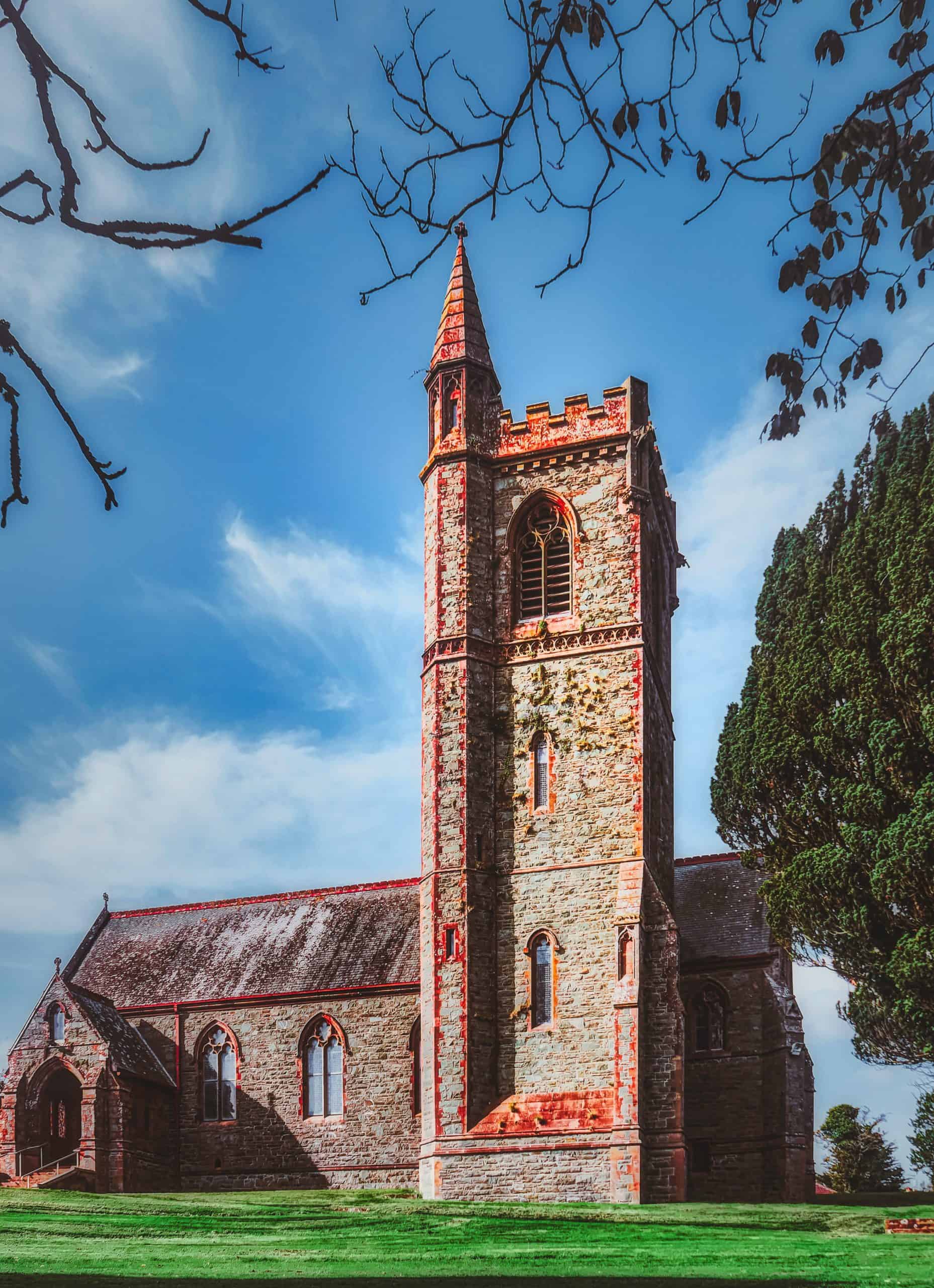The Stunning Dundrum Castle, County Down, Northern Ireland

Updated On: March 14, 2024 by Ciaran Connolly
Perched atop a rugged hillside overlooking the quaint village of Dundrum in County Down, Northern Ireland lies a timeless testament to the region’s rich history and enduring heritage: Dundrum Castle. Steeped in tales of battles, sieges, and royal intrigue, this imposing fortress symbolises the area’s tumultuous past and enduring resilience. With its commanding presence and breathtaking views of the surrounding landscape, Dundrum Castle continues to captivate visitors from near and far, offering a glimpse into a bygone era of knights, nobility, and medieval grandeur.
Dundrum Castle History
Early History
The history of Dundrum Castle dates back to the 12th century when it was built by John de Courcy, a Norman knight who played a significant role in the Anglo-Norman conquest of Ireland. De Courcy constructed the castle to consolidate Norman’s control over the region and establish a strategic stronghold in County Down. Situated on a rocky outcrop overlooking the fertile plains below, Dundrum Castle was a formidable defensive position, guarding the approaches to the nearby town of Downpatrick and the ancient ecclesiastical centre of Bangor.
The original structure consisted of a stone keep surrounded by a curtain wall, a central courtyard and various outbuildings. The castle’s commanding position afforded its occupants a clear view of approaching enemies, allowing them to defend against potential attacks. Over the centuries, Dundrum Castle underwent several phases of expansion and modification, reflecting the changing military tactics and technological advancements of the time.
Medieval Period
During the medieval period, Dundrum Castle played a central role in the power struggles and conflicts that defined the history of Ireland. As various Gaelic chieftains vied for control of the region, the castle changed hands multiple times, passing between Norman lords, Gaelic clans, and English monarchs. Its strategic significance made it a coveted prize for those seeking to assert their authority over the surrounding lands.
One of the most notable episodes in Dundrum Castle’s history occurred during the 16th century when it became embroiled in the tumultuous events of the Tudor conquest of Ireland. In 1572, the castle was besieged by forces loyal to Queen Elizabeth I during the Desmond Rebellions, a series of uprisings against English rule in Ireland. Despite fierce resistance from the defenders, the castle eventually fell to the English troops, marking a significant victory for the crown.
Throughout the medieval period, Dundrum Castle continued to serve as a symbol of authority and control, its imposing silhouette dominating the landscape and asserting the dominance of its owners. However, as the centuries passed, the castle gradually fell into disrepair, its once-mighty walls crumbling and its towers crumbling to ruin.
Modern Era
By the 18th and 19th centuries, Dundrum Castle had ceased to serve any practical military function and had fallen into neglect. Its strategic importance diminished and became little more than a picturesque ruin, attracting the attention of artists, poets, and antiquarians drawn to its romantic allure. Painters like William Turner and poets like William Wordsworth immortalized the castle in their works, capturing its atmospheric beauty and evocative charm.
In the late 19th and early 20th centuries, efforts were made to preserve and protect Dundrum Castle as a historic monument. The castle came under the care of the Northern Ireland Environment Agency, which undertook restoration work to stabilize the ruins and make them accessible to visitors. Today, Dundrum Castle is a popular tourist destination, offering visitors the chance to explore its ancient walls, climb its towers, and soak in the stunning views of the surrounding countryside.
The Scottish Connection
In the 14th century, Dundrum Castle entered a new chapter in its storied history with the arrival of the Scottish nobleman Sir John Stewart of Bonkyll. Acquiring the castle through marriage to the daughter of its then-owner, Sir John Stewart, brought with him a new era of prosperity and influence for Dundrum and its surrounding lands. Under Stewart’s stewardship, Dundrum Castle underwent extensive renovations and enhancements, transforming it into a grand fortress befitting its status as a seat of power.
The most notable addition made during Stewart’s tenure was the construction of the imposing gatehouse, a formidable structure designed to control access to the castle and deter potential attackers. Featuring thick stone walls, a portcullis, and defensive battlements, the gatehouse served as the primary entrance to the castle and a symbol of its owner’s authority. Within its walls, visitors would pass through a series of checkpoints and defences before gaining admittance to the castle’s inner sanctum, a testament to its builders’ strategic foresight and military prowess.
Stewart’s legacy at Dundrum Castle extended beyond its physical infrastructure, leaving an indelible mark on the cultural and social fabric of the surrounding community. As a patron of the arts and literature, Stewart fostered a thriving cultural milieu within the castle walls, hosting poets, musicians, and scholars from near and far. His patronage also extended to the church, with Stewart endowing the nearby parish church of St. Nicholas and supporting its clergy in their pastoral duties. Through his efforts, Dundrum Castle emerged as a beacon of enlightenment and refinement in the heart of County Down, attracting visitors from across the British Isles and beyond.
Architecture and Features
Dundrum Castle is a fine example of medieval military architecture characterized by its strategic location, robust construction, and defensive features. The castle’s design reflects the typical Norman motte-and-bailey style, with a central keep surrounded by a curtain wall and outer defences. The keep consists of a massive stone tower, initially several stories high, which served as the primary residence for the castle’s occupants.
The curtain wall, which encircles the inner courtyard, was once equipped with battlements, arrow slits, and other defensive features designed to repel attackers. Small towers and bastions provided additional protection at various points along the wall and served as lookout posts. A series of gates controlled access to the castle, with drawbridges, portcullises, and other mechanisms designed to thwart would-be invaders.
Despite its imposing appearance, Dundrum Castle possesses elegance and grace, with its weathered stone walls and ivy-clad towers blending harmoniously with the surrounding landscape. The castle’s location atop a rocky hill offers panoramic views of Dundrum Bay and the Mourne Mountains, creating a sense of awe and wonder for those who visit.
Rediscovery and Restoration
In recent decades, Dundrum Castle has experienced a renaissance, as efforts to preserve and restore this iconic landmark have breathed new life into its ancient stones. Recognising the cultural and historical significance of the castle, local authorities and heritage organisations have undertaken extensive conservation work to stabilise the structure and protect it for future generations. Through careful restoration and interpretation, Dundrum Castle has become a focal point for visitors seeking to uncover the secrets of Northern Ireland’s past and explore its architectural heritage.
Today, visitors to Dundrum Castle can wander through its evocative ruins, marvelling at the craftsmanship of its medieval builders and imagining the lives of those who once inhabited its hallowed halls. From the imposing keep to the crumbling remnants of the gatehouse, each stone bears witness to the passage of time and the enduring spirit of resilience that defines this remarkable edifice. Interpretive signage and guided tours offer insight into the castle’s history and significance, shedding light on the events and personalities that shaped its destiny.
Visiting Dundrum Castle
Today, Dundrum Castle is open to the public, allowing visitors to explore its ancient ruins and learn about its fascinating history. A visitor centre provides information about the castle’s origins, construction, and historical significance, while guided tours offer insights into its medieval past. Interpretive panels and exhibits help bring the story of Dundrum Castle to life, shedding light on the lives of the people who lived and worked within its walls.
For those feeling adventurous, climbing to the top of the castle’s towers offers unparalleled views of the surrounding countryside, with sweeping vistas stretching from the rugged coastline to the verdant hills beyond. The castle grounds also offer picnicking, hiking, and wildlife-spotting opportunities, making it an ideal destination for outdoor enthusiasts and history buffs.
The Mourne Mountains

The stunning surroundings of the Mourne Mountains, near Dundrum Castle, were used three times as filming locations for Game of Thrones. In the Game of Thrones season one, the area was used to film the entry to Vaes Dothrak.
Vaes Dothrak is where the Dothraki leaders (khalasars) gather and meet to trade, but not to fight, as it is considered a place of peace.
Vaes Dothrak is the only city in the Dothraki Sea located near the region’s far northeastern edge. The entrance to Vaes Dothrak is marked by two giant statues of a pair of stallions.
In season three, the show moved a bit to the nearby Tollymore Forest to film Theon’s attempted escape from the torture he’d been suffering at the hands of Ramsey Bolton. Ramsey holds Theon captive and tortures him mercilessly, both physically and mentally, turning him into a completely broken man and renaming him “Reek”. Tollymore Forest Park appeared again as the Haunted Forest, where the White Walkers first appeared to move southward, attempting to rejoin the rest of the human world. It is also where the Starks discover the dire wolves the Stark children chose to keep as pets. Leitrim Lodge, located down at the foothills of the Mournes, was north of Winterfell, where Bran first meets Jojen and Meera.
The Mournes, near Dundrum Castle, are known to have inspired author CS Lewis to create the magical world of Narnia.
Conclusion
Dundrum Castle is a testament to the enduring legacy of Ireland’s medieval past, a symbol of strength, resilience, and perseverance in the face of adversity. From its humble beginnings as a Norman fortress to its role in shaping the course of Irish history, the castle has witnessed centuries of triumphs and tragedies, leaving an indelible mark on the landscape and the imaginations of all who encounter it.
As visitors wander through its ancient ruins and soak in the breathtaking views from its battlements, they cannot help but be transported back to an era of knights and kings, battles and sieges. Dundrum Castle is more than just a historic monument; it is a living testament to the enduring spirit of Northern Ireland and the rich tapestry of its past.
In the heart of County Down, amidst the rolling hills and rugged coastline, Dundrum Castle stands as a silent sentinel, watching over the land and the sea, a reminder of a bygone age and a beacon of hope for future generations.






